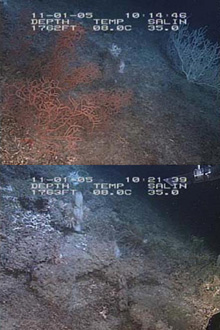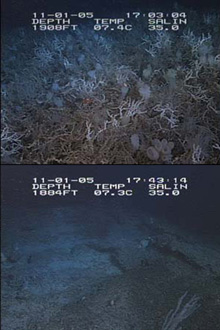
Figure 1. The habitat at the morning dive at north Jacksonville was a diverse mixed habitat. This area had a higher abundance of black corals than the dive site further south. Click image for larger view and image credit.
Three Times a Charm for Jacksonville
November 1 , 2005
Dr. Martha Nizinski
Co-Principal Investigator
NOAA Fisheries Service
After traveling back and forth between Savannah Banks and Jacksonville in search of calmer seas, we are finally able to dive at our Jacksonville sites today. These sites are a high priority for our mission since they represent yet another type of deep coral habitat. Through the course of our mission we have documented the changing environment as we move southward. In addition to documenting the biodiversity and examining habitat associations, we will also use these data to examine transitions in the faunal assemblages with changing latitude.
The sites here are very different from the prime Lophelia reef habitat observed off North Carolina and the low relief, high sediment sites at Savannah banks. These sites are most similar to the ridge and valley system observed at Stetson banks, yet the assemblage of organisms is quite different.
The first dive targeted the northern end of the Jacksonville site. Our team described the dive site as a highly diverse mixed habitat with small patches of live Lophelia interspersed throughout high concentrations of soft corals, black corals, sponges and stalked crinoids. The habitat remained relatively consistent through out the dive. Spending an entire dive in this kind of habitat provided us a great opportunity to increase our transect data and make observations on habitat associations between corals and the larger invertebrates over a small spatial scale.

Figure 2. The dive track from the afternoon dive crossed three different habitat types. These two photos show the stark contrast between the high diversity assemblage and the barren landscape. Click image for larger view and image credit.
We moved further south to make the afternoon dive. Through the course of the second dive of the day we traveled across three different habitat types. When we first reached the bottom (approximately 1900 ft; 580 m) the underlying substrate of coral rubble was covered with living organisms. Small patches of Lophelia and other hard corals, including Enallopsammia and Madrepora, soft corals, and an extremely diverse glass sponge assemblage, dominated this area. Large mobile epifauna was also present in greater abundance than what we observed at Stetson or Savannah banks. For example, the squat lobster Eumunida picta was observed at densities that rival our North Carolina sites. This was quite different from Savannah where almost no squat lobsters were seen. The second habitat type we encountered was more barren. The abundance and diversity of the attached fauna and the mobile invertebrates decreased dramatically. Much more of the sediment covered coral rubble was visible and individual organisms were much more widely spaced. The third type of habitat was more like pavement or large rocks stacked in a haphazard arrangement. Diversity was quite low here. It was only in this environment that we observed the few individual black and bamboo corals that we encountered. As we continued to transect through the area we returned to the high diversity habitat. It was quite interesting to see such dramatic changes in the habitat over a relatively small spatial scale. One other observation worth noting for this dive was that we saw a chair at about 2000 ft (610 m). It had obviously been there for a while since it had been colonized by several species of glass sponges. We also noticed some fishing line. This was the first time we have observed any trash on the bottom at our study sites on this cruise.
Each dive continues to provide a wealth of information. We observed and collected several different kinds of organisms, including soft corals and sponges, which we had not previously seen in this area. We also have video of a fish that we have not before. The number of species included in our biodiversity database is increasing at a fairly steady rate, demonstrating to us that we still have more to learn about the faunal composition of these deep coral habitats.
Life on the Edge will be sending daily reports from Oct 16 - Nov 4. Please check back frequently for additional logs from this expedition.
Sign up for the Ocean Explorer E-mail Update List.

























